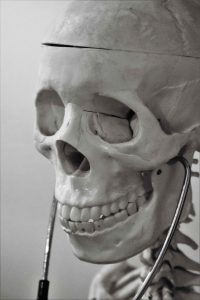Teaching as Immortality
The Big Idea
Teaching as a profession can be an immortality project, a form of compensation to help resolve a certain kind of existential terror.

Ultimately, self-esteem and maintaining faith in a cultural worldview serve to alleviate the fear of inevitable death by providing people with a sense of life-continuity, or immortality, which can be literal or symbolic. The TMT sense of self-esteem (not to be confused with a more commonplace understanding) does not have the endgame of simply feeling good about yourself; rather, it is specifically the feelings of having a meaningful, significant existence. This self-esteem is linked to our literal and symbolic immortality. Literal immortality refers to the story a culture tells the group about what happens after death, which for most of the world’s religions involves some form of existence in the afterlife. There are non-religious understandings as well, such as taking comfort in the recycling of the atoms and energy that make up our bodies per the First Law of Thermodynamics. Symbolic immortality refers to symbolic extensions of the self through lifelong achievements (e.g., books, works of art, children) that will live on in the culture after physical death.

The pursuit of self-esteem through teaching is a symbolic immortality project when the terror of individual death is alleviated by the teacher’s ability to pass along particular values and attitudes to their students; i.e., teachers can reproduce certain versions of themselves through schooling (van Kessel & Burke, 2018). Along this line, teachers can see their students similar to how they might see their children. Teachers-as-quasi-parents can bequeath their ideas and commitments as part of their legacy to the next generation. The profession has long been fundamentally about creating legacies, illustrated by the common practice of teachers referring to their students as their own: “my kids” or “our kids.”

It is vital for us to question the goal of recreating the self in education. This framing is not to downplay that teachers can make a difference in the students’ lives; rather, the call is to be thoughtful about our motivations and the potential harmful (albeit unintended) consequences. With teaching as an immortality project, both students’ and teachers’ lives are on the line. Because teaching is at least partly about delaying the terror of individual death, there is a danger of overly investing in molding students in a very particular way, thus foreclosing educational opportunities.
The danger lies in failing to listen to our students and their particular needs and desires. Within teaching is a semblance of a saviour-complex (Burke & Segall, 2015) which can mean that we impose our will upon our students. To be clear, people (including teachers) should do whatever they can to work toward their preferred future for society, but it is folly to place expectations on an individual teacher to change the world singlehandedly. Teachers need to consider what their theory of change is—the mechanisms by which societies have changed, and will continue to—and then operate within that framework. Furthermore, there is a danger to psychological well-being when teachers’ professional self-esteem is contingent upon students mimicking teachers’ beliefs and actions. If teachers do not receive the attention from their students and colleagues as expected, their self-esteem is threatened due to mortality salience. Creating teacher legacies helps teachers deal with death, even if they do not know that death is a motivating force, but the cost is that we create a situation with cosmic stakes. Although teachers can begin their careers brimming with a moral purpose that is construed as socially meaningful, they can burn out and sink into despair as they feel inconsequential. We need to challenge the teacher-as-saviour model, which involves interrogating the existential elements that underlie it.
Suggested Readings for further study
Burke, K. J., & Segall, A. (2015). Teaching as Jesus making: The hidden curriculum of Christ in schooling, Teachers College Record, 117(3), 1–27.
van Kessel, C., & Burke, K. (2018). Teaching as immortality project: Positing weakness in response to terror. Journal of Philosophy of Education, 52(2), 216-229. doi:10.1111/1467-9752.12301
(Created by C. van Kessel, 2018)
Most commonly these terms refer to the anxiety and fear that comes with knowing that we will eventually die. Existential anxiety can also refer more broadly to the unease that accompanies thinking about any potentially unpleasant aspect of our existence including meaninglessness, mortality, isolation, and freedom and responsibility.
Is a subfield of social psychology that is derived from existentialism and the works of Ernest Becker. TMT posits that our awareness of death conflicts with our evolved desire to live and that this creates the potential for debilitating existential anxiety (i.e., “terror”). Furthermore, it proposes that humans have attempted to psychologically resolve the problem of death by inventing and sustaining self-esteem-yielding cultural worldviews that help to manage this anxiety. These cultural systems enable people to curtail death related anxiety by providing hope for immortality. According to TMT, immortality can be literal, such as a belief in an afterlife (e.g., heaven). However, we can also attain symbolic immortality through a cultural system (e.g., one’s country) which allows its adherents to construe themselves as valuable members whose memory and contributions will persist posthumously through the permanency of that culture or the objects that it fosters.
The feeling that one is a valuable member of a meaningful world. When we live up to the values and standards of our culture, we gain self-esteem that helps protect us from our anxiety about death and serves as a measure of our eligibility for literal or symbolic immortality.
The state of having death on your mind. When we say mortality is salient, it means that one has been reminded of death.

